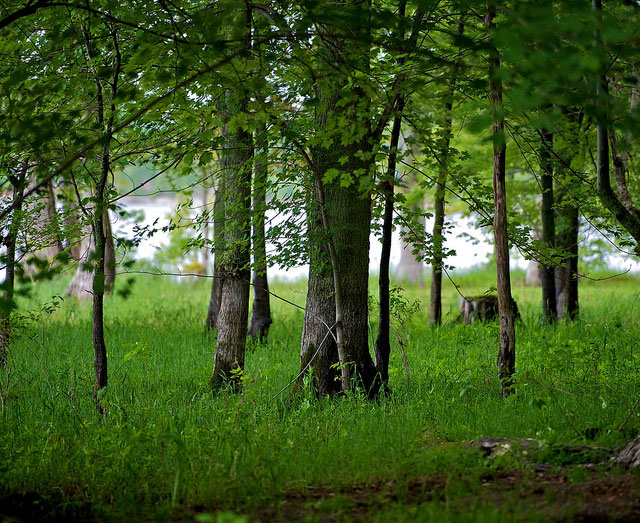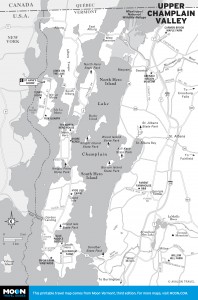
Situated at the far northern end of Lake Champlain, the Isle La Motte is a haunting terrain of sparse forest and windswept solitude. Photo © Josh Engroff, licensed Creative Commons Attribution.

Upper Champlain Valley
With more shoreline than any other part of Vermont, this cluster of five quiet islands feels entirely separate from the rest of the state—if not the world. Water seems to be everywhere, as do farms, humble homes, and friendly residents who all seem to be on a first-name basis with each other. The central island is appropriately named Grand Isle, flanked to the south by the attached South Hero and to the north by the sinuous North Hero, which has as much of a downtown as the islands have to offer. By contrast, the most secluded of the isles is the haunting Isle La Motte, home to a Catholic pilgrimage site and former site of the first settlement in the state. La Motte offers tranquil views of the lake all the way to the New York coast.Discovered approximately 400 years ago by Samuel de Champlain, the islands are good for those seeking history as well as a little R&R. They’re home to New England’s oldest log cabin (on Grand Isle), and each island’s individual historical societies showcase artifacts from the islands’ early settlers. All that said, besides a handful of other sights of note there isn’t much else to do here—which is precisely how many visitors would have it.
Situated at the far northern end of Lake Champlain, the Isle La Motte is a haunting terrain of sparse forest and windswept solitude. It must have seemed all the more desolate in 1666, when the first settlement in Vermont, Fort St. Anne, was built by French explorers under the command of Pierre de St. Paul, Sieur La Motte. They took solace in a shrine built to St. Anne, staffed by Jesuit priests who accompanied the expedition.
Four hundred years later, the shrine (West Shore Rd./Shrine Rd., Isle La Motte, 802/928- 3362, 9 a.m.–7 p.m. daily mid-May–mid-Oct., tours every half-hour, $2 adults) still exists as a Catholic pilgrimage site, though the current building dates only from the late 19th century. In addition to the main building, where mass is still said regularly in season, the picturesque lakeshore is dotted by various grottoes filled with religious statues, including a 15-foot gold-leaf statue of the Virgin Mary rescued from a Burlington cathedral. Up the hill, a rectory and cafeteria has a small museum full of relics dating back to the French occupation in the 17th century. The lake itself is fittingly graced by a statue of the man who discovered it in 1609, explorer Samuel de Champlain, sculpted by F. L. Weber for the Montreal Expo in 1967.
The “heroes” for which the islands are named lived at the Hyde Log Cabin (228 U.S. 2, Grand Isle, 802/828-3051, 11 a.m.–5 p.m. Thurs.–Mon. July–mid-Oct., $2 adults, children 14 and under free), an original 1785 home built by Jedediah Hyde and his father, who were both veterans of the Revolutionary War. The cabin was originally located two miles to the southwest; it was moved to its current location by the Vermont Historical Society and filled with old surveyor maps and other artifacts from the earliest days of the islands.
The best place to get in touch with the agricultural ambience of the islands is Allenholm Farm (150 South St., South Hero, 802/372-5566, 9 a.m.–5 p.m. daily), which has a petting paddock full of animals, including two donkeys, a Scotch Highland cow, and a fat ewe with a taste for peppermints. A farm stand sells apples and farm-made apple pies.
The legacy of Lake Champlain’s prehistoric sojourn in the tropics is on view at the Fisk Quarry (The Main Road, Isle La Motte, 802/862-4150). Poking out of the quarry walls are the fossilized remains of the 480-million-year-old Chazy Coral Reef, the oldest known coral reef in the world. Its stony sides are visibly embedded with stromatoporoids, ancient ancestors of modern-day sea sponges.
Vermont’s oldest winery, Snow Farm Vineyards (190 W. Shore Rd., South Hero, 802/372-9463, 10 a.m.–5 p.m. daily May–Dec.) has won multiple awards for its delicate pinot noirs and vidal blanc ice wines. Tours of the winery are offered daily at 11 a.m. and 2 p.m. During the summer, the vineyard sponsors a Music in the Vineyard series on Thursday nights, in which locals bring blankets and corkscrews and sip under the stars.
All of Lake Champlain becomes a stage each summer, when the Vermont Shakespeare Company (North Hero, 877/874-1911) performs outdoors at Knight Point State Park. A celebration as American as you-know-what, Apple Fest (South St., South Hero, 802/372-8400, Oct.) celebrates the yearly harvest with cider, auctions, a craft show—and, of course, plenty of pies.
The Lake Champlain Islands Chamber (3501 Rte. 2, North Hero, 802/372-8400) has information at its office on North Hero Island. There’s a Merchants Bank (301 U.S. Route 2, Grand Isle, 802/372-4222, 9 a.m.–4 p.m. Mon.– Thurs., 9 a.m.–5:30 p.m. Fri.) right before the bridge to North Hero.
Excerpted from the Third Edition of Moon Vermont.